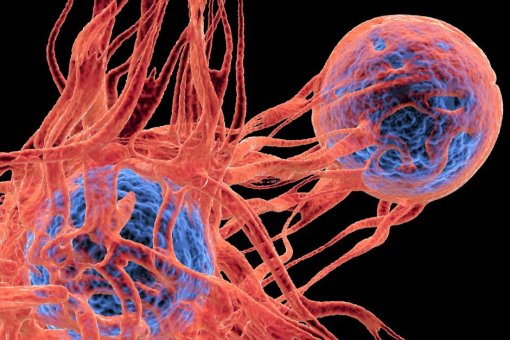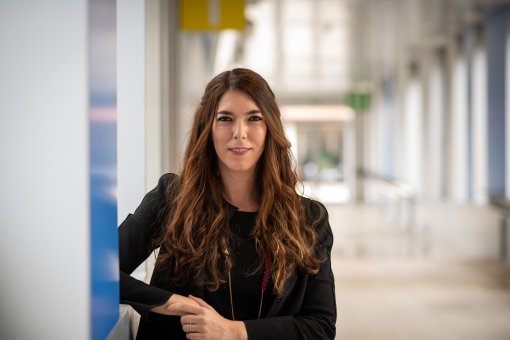Images
Participants

Contact

The renowned scientist joins the Institute for Research in Biomedicine (IRB Barcelona) after 13 years at CNIO, funded by the “la Caixa” Banking Foundation and by the Government of Catalonia's ICREA programme.
Manuel Serrano will study how damaged tissue is repaired and search for therapies based on regenerative medicine for the treatment of diabetes and other diseases.
This morning, the scientist Manuel Serrano, the director of the Institute for Research in Biomedicine (IRB Barcelona) Joan J. Guinovart, the director of Research and Knowledge Section of the “la Caixa” Banking Foundation Jordi Portabella, and the director of the Institució Catalana de Recerca i Estudis Avançats (ICREA) Antonio Huerta have presented the challenges in regenerative medicine that Serrano will tackle from his new Cellular Plasticity and Disease Lab at IRB Barcelona.
Manuel Serrano (born Madrid, 1964) comes to IRB Barcelona under an ICREA Research Professor contract from the Government of Catalonia and with funding from the “la Caixa” Banking Foundation, the latter will support the research undertaken by his lab, which comprises 14 scientists. “This support from public and private sectors is crucial as it will allow us to make a qualitative leap in our research,” said Serrano in a press conference held at IRB Barcelona, located at the Barcelona Science Park.
Jordi Portabella said, “One of our priorities is to foster talented senior researchers by providing them with everything they need to reach their full potential and to develop science of excellence in the centres in in Spain. This strategy thus strengthens cutting-edge research with the potential to benefit society”. Antonio Huerta commented, “ICREA is an organisation run by the Government of Catalonia that seeks to draw talent into our research system. Each year it brings outstanding scientists into the best universities and research centres in Catalonia. ICREA, an organization based on collaboration, has been operating for 15 years and has made this new recruitment possible”.
“IRB Barcelona boasts an outstanding scientific team which will now be strengthened with the recruitment of another ace,” said Joan J. Guinovart. “Research of excellence is only possible when supported by both competitive and philanthropic funding,” he added.
“Thirteen years at the Spanish National Cancer Research Centre (CNIO) has allowed me to mature as a scientist and the freedom I enjoyed there gave excellent results,” says Serrano. He explains that his interest “has moved from cancer to tissue repair and cell reprogramming”—fields linked to many disciplines—and that “the multidisciplinary context of IRB Barcelona brings an advantage to establish new collaborations.
Reprogramming, repairing, and regenerating
Defective repair processes are at the root of many diseases, such as cancer, and cell aging. The research done in Serrano’s lab aims to unravel how tissue damage is repaired and clarify the link between cell reprogramming and repair. “It is a field about which little is known and in which we have an advantage that we wish to exploit,” says the researcher. In 2013 Serrano published a scientific breakthrough in Nature in which he successfully reprogrammed cells for the first time within a living organism. In 2016 he published an article in Science in which he demonstrated that tissue damage is a relevant factor for cells to return to a state that is similar to the embryonic one. Both findings, together with previous breakthroughs in oncology, have established him as an international authority in biomedicine.
Lung, breast and pancreas cells, like cells from any other tissue, are highly specialised. In order to repair damage, these cells first have to become non-specialised, which is achieved by reprogramming their genome—meaning some genes are switched off and others on—in such a way that the cell stops doing what it did before, becomes more versatile, and acquires the capacity to repair damage. “We and other scientists are fascinated by this intermediate state of non-specialisation,” said Serrano. “In fact, the objective in medicine is not to achieve embryonic reprogramming (embryonic cells can become any cell type) because it isn’t necessary, but rather partial reprogramming through which repair mechanisms can be regulated,” he explains.
Diabetes and lung fibrosis
Serrano and his team are working on two very different diseases with the aim to further regenerative medicine. The first is lung fibrosis, a rare degenerative condition that has no cure. The second is diabetes, which is highly prevalent and for which chronic treatments are available. “In diabetes, the insulin-producing cells in the pancreas are damaged and the goal is to get the pancreas to regenerate these cells,” he says.
Lung fibrosis is a disease in which the lung accumulates damaged (senescent) cells. They are not removed or replaced by healthy ones. “We are attempting to remove these damaged cells to see whether we can reactivate tissue repair mechanisms,” he explains.
First spinoff
Serrano has taken steps to bring the benefits of his discoveries closer to patients with lung fibrosis. In parallel to setting up his new lab, he has cofounded, together with three colleagues, his first biotech spinoff, which is currently located on the same premises as IRB Barcelona, at the Barcelona Science Park.
Called Senolytic Therapeutics, the spinoff will develop future clinical trials of a drug developed and patented by the group and that selectively kills damaged lung cells and improves lung fibrosis. The drug candidates have shown to be effective in mice. “In the case of a rare disease for which there is no efficient treatment, even a small improvement can be considered a success because it can bring about a significant increase in the quality of patients’ lives,” explains the researcher. “We will also produce new compounds with the potential to treat lung fibrosis and similar diseases,” he says.
Serrano considers Barcelona to be a major biomedical hub in Europe. “Flexible and dynamic research centres and a talent attraction programme like ICREA based on competence, scientific merit and creativity are the two key components for a solid research system. If we add to this the growing support of private foundations such as “la Caixa”, the momentum will be even greater”. With Manuel Serrano’s group, IRB Barcelona now has 25 laboratories, three of which have been set up in the last six months.
More information: INTERVIEW. Manuel Serrano: “Moving into a new centre and city requires some personal reprogramming”
Short biography
Dr. Manuel Serrano did his PhD under the supervision of Margarita Salas (CBM-CSIC, Madrid) and a postdoctoral stay in David Beach’s lab (Cold Spring Harbor Laboratory, NY, USA) from 1992 to 1996. During this time, he made one of his most important contributions, namely the discovery of the tumour suppressor p16. Dr. Serrano established his own research group in 1997, first at the National Center of Biotechnology (CNB-CSIC, Madrid) and from 2003 to May 2017 at the CNIO.
The main contributions of Dr. Serrano’s lab during these years are related to the concept of oncogene-induced senescence and the anti-ageing activity of tumour suppressors. More recently, his group has reported on the relevance of tumour suppressors in metabolic syndrome, the existence of senescence during embryonic development, and the feasibility of embryonic reprogramming within living adult organisms (the latter was considered "Achievement of the Year 2013" in the stem cells field by Nature Medicine).
Dr. Serrano’s track record has been recognised by several awards and honors: the FEBS Anniversary Prize, given by the Federation of European Societies of Biochemistry (FEBS); the National Award of Oncology, given by the Echevarne Foundation; the National Award of Biomedical Research, given by the Banc Sabadell Foundation; and the Fundación “Carmen y Severo Ochoa” Award. He is member of the European Molecular Biology Organization (EMBO), the Royal National Academy of Medicine of Spain, and the European Academy of Cancer Sciences, as well as editorial board member of several international scientific journals.
Recent major funding for Dr. Serrano’s group includes two consecutive European Research Council (ERC) Advanced Grants and participation in EU-FP7 grants.
About IRB Barcelona
Created in 2005 by the Generalitat de Catalunya (Government of Catalonia) and University of Barcelona, IRB Barcelona is a Severo Ochoa Centre of Excellence, a seal that was awarded in 2011. The institute is devoted to conducting research of excellence in biomedicine and to transferring results to clinical practice, thus improving people’s quality of life, while simultaneously promoting the training of outstanding researchers, technology transfer, and public communication of science. Its 25 laboratories and seven core facilities address basic questions in biology and are orientated to diseases such as cancer, metastasis, Alzheimer’s, diabetes, and rare conditions. IRB Barcelona is an international centre that hosts 400 employees and 32 nationalities. It is located in the Barcelona Science Park. IRB Barcelona forms part of the Barcelona Institute of Science and Technology (BIST) and the “Xarxa de Centres de Recerca de Catalunya” (CERCA).
About IRB Barcelona
The Institute for Research in Biomedicine (IRB Barcelona) pursues a society free of disease. To this end, it conducts multidisciplinary research of excellence to cure cancer and other diseases linked to ageing. It establishes technology transfer agreements with the pharmaceutical industry and major hospitals to bring research results closer to society, and organises a range of science outreach activities to engage the public in an open dialogue. IRB Barcelona is an international centre that hosts 400 researchers and more than 30 nationalities. Recognised as a Severo Ochoa Centre of Excellence since 2011, IRB Barcelona is a CERCA centre and member of the Barcelona Institute of Science and Technology (BIST).






